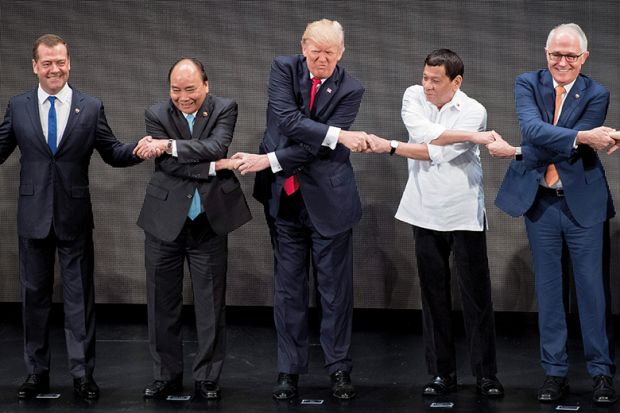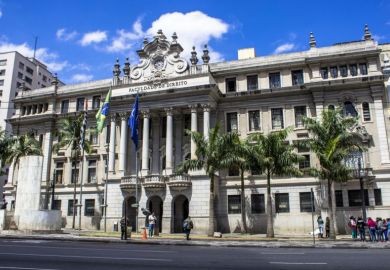Browse the full THE Asia-Pacific University Rankings 2019 results
For a focus on the public good to go beyond a token gesture, universities need to take full account of geopolitical realities and the pressures that limit their impact on society.
National funding regimes for research universities mirror the range of geopolitical contexts in the Asia-Pacific region. The limits imposed or incentives provided by governments vary from democratic polities under threat of authoritarian white nationalism promulgating austerity budgets, to authoritarian, one-party economies committed to public funding of research universities and with their own ethnic essentialism.
The countries of the organisation Asia-Pacific Economic Cooperation (APEC) account for an estimated 40 per cent of the world’s population, 60 per cent of global gross domestic product and 47 per cent of global trade. Its 21 member states also include strong research powers: the US, Canada, China, Japan, South Korea, Australia and Russia. Universities across these nations must learn to thrive in the complex geopolitical dynamic of both competition and collaboration in the drive for technological leadership that bolsters national security and economic growth.
View this year’s Asia-Pacific University Rankings methodology in full
National economic and political objectives appear increasingly to be in contradiction to the strategies that are required to solve global crises such as inequality, environmental destruction and climate change. This disconnect exacerbates the gap between the social and geographic locations where the research aimed at solving global crises takes place and the areas where disasters and disease burdens, for example, are greatest. Research universities need to come up with new strategies in this complex environment.
But what strategies are available to universities to help them to fully contribute to the public good when they have limited capacity to decide their own academic priorities, whether because of funding limitations, political constraints or the restricted intellectual autonomy of individual scholars?
University rankings are among those auditing mechanisms that have crossed over from offering useful insights on an institution’s comparative capabilities in a national context into maintaining an international hierarchy of uniformity devoid of the complexity and nuance of each institution’s setting. Governments, businesses, donors, parents and students are in thrall to rankings. We must redirect this ambiguous authority in order to emancipate universities, at least to a degree, from the fetters of false expectations and public policy constraints. Attention to the ultimate purpose of higher education – the public good – is a welcome first step.
The public good is now increasingly defined by challenges and crises that go beyond national borders, just as much research focuses on the issues of global science, planetary health, technological discovery and the universal human condition. An educated population whose basic needs are met and who are able to exercise the rights of free citizens is the strong base the world requires to solve these challenges. Achievement of the public good underlies our ability to pursue the global common good.

But how do we act at scale so as to have real impact? How can research universities work together for this purpose? And do international university networks have a role to play?
It has long been clear that university networks that might have been established for mutual exchange and inward-facing collaborations now have the potential to leverage their collective capabilities into international public policy. Regrettably, few have taken more than tentative steps in this direction.
The imperative of the Association of Pacific Rim Universities (APRU) is to create the conditions for more extensive collaboration across borders. Our task is:
- to aggregate at scale and at the international level the social power of knowledge and innovation through providing neutral platforms for cooperation
- to sustain a commitment to multilateralism in the midst of economic nationalism through partnerships across borders and sectors
- to speak to the kind of world we want to create, and to the kinds of values we aspire to uphold in our societies and in the international community
- and to secure the future through commitment to the global common good.
Download a copy of the Asia-Pacific University Rankings 2019 digital supplement
Paradoxically, the current geopolitical environment increases the potential of networks to create neutral international platforms for collaboration on global challenges and unofficial platforms that act as super-connectors, amplifying the impact of research on policy development and technical solutions at the international level.
Evidence shows that global science is being shaped by a remarkable expansion over the past 30 years of international scientific collaboration through a system of open networks not directly subject to national governance or evaluation regimes. These networks have formed partly in response to the complexity of global challenges and include countries where research funding is very constrained or where civil rights, including academic freedom, are under attack.
As a network of 50 leading research universities from 17 highly diverse APEC economies around the Pacific Rim, APRU leverages the research and education capabilities of its members into the international public policy process on common challenges such as women in leadership, ageing populations, artificial intelligence and sustainable cities.
Essential to the success of this network strategy is partnership with other sectors: multilateral organisations, the private sector, foundations and governments. These are partnerships where the collective efforts of our members add unique value. We build coalitions with cities, communities and non-governmental organisations.
A report that we released in October 2018, Amplifying Impact: Transformative Solutions to Asia-Pacific Challenges, is replete with examples of such collaborations and their impact. A major theme of the case studies and analysis is the need for models of collaboration between STEM disciplines and the social sciences and humanities in comprehending, framing and finding solutions to global challenges. The report gives many examples of current initiatives and what we can learn from them.
We are finding that a network strategy has a new salience in the midst of rapid change, turbulence and uncertainty.
A network with enormous geographical reach and depth of knowledge in highly diverse environments is a huge resource, especially as other forms of cooperation attenuate or disappear. While many bilateral relations are under strain, we remain a portal or connector that can be used to mobilise resources of knowledge and innovation to advance the global common good.
Christopher Tremewan is secretary general of the Association of Pacific Rim Universities.
POSTSCRIPT:
Print headline: The network as catalyst
Register to continue
Why register?
- Registration is free and only takes a moment
- Once registered, you can read 3 articles a month
- Sign up for our newsletter
Subscribe
Or subscribe for unlimited access to:
- Unlimited access to news, views, insights & reviews
- Digital editions
- Digital access to THE’s university and college rankings analysis
Already registered or a current subscriber?








